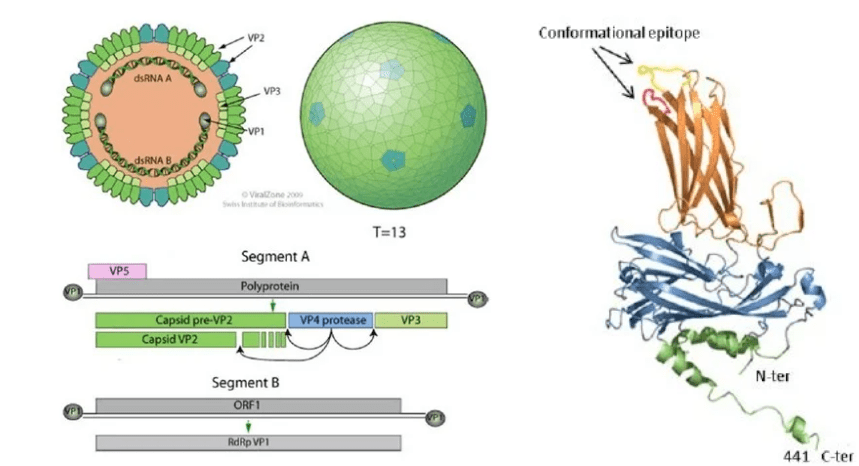Antigenic drift in variant Infectious bursal disease viruses can be explained by a single point of mutation in the VP2 protein
30 August 2024
Outbreaks of infectious bursal disease (IBD) are still reported throughout the world despite efforts to control the disease through vaccination. Control efforts are complicated by the fact that the causative agent is subject to frequent genetic mutations, reassortment of genome segments, and genomic recombination events that can potentially increase virulence and alter antigenicity. It is known that antigenic variants of IBDV possess modified neutralizing epitopes that allow them to evade the action of maternally-derived or vaccine-induced antibodies.
IBDV is a member of the family Birnaviridae and contains a double-stranded RNA genome consisting of two segments, A and B. Segment A encodes the VP2, VP3, VP4 and VP5 proteins, while segment B encodes the protein VP1. The VP2 protein is the major host-protective immunogen of IBDV and carries all the neutralizing epitopes, some being responsible for antigenic variation (Brown et al., 1994). It also contributes to the antigenicity, tropism and pathogenicity of the virus. It forms trimeric sub-units to build the viral capsid and exhibits surface projections corresponding to the central or hypervariable region, the part of the VP2 protein most exposed to immune pressure and hence the one most prone to mutations.

Antigenic drift is thought to be responsible for the formation of antigenic IBDV variant strains, due to substitution mutations in the hypervariable region of VP2 (Heine et al., 1991). Some of these amino acid mutations enable the virus to escape from neutralizing antibodies produced by vaccination with classic IBDV strains. In 2011, Daral J. Jackwood and Susan E. Sommer-Wagner published a study in which the effect of amino acids 222 and 254 on antigenicity of the variant Del-E strain of IBDV was examined.
“ Amino acids contributing to antigenic drift in the infectious bursal disease Birnavirus (IBDV) ”
The main objective was to assess whether a single point mutation could significantly contribute to antigenic drift in the Del-E strain of IBDV, allowing the virus to evade the humoral immunity induced by the original Del-E virus variant IBDV vaccine.
Two Del-E strain viruses with different single substitution mutations (Fig 1) were obtained from a Del-E virus (strain 89/03) and their antigenic property was assessed in vivo for the first time ever reported:
These mutations were selected since they were observed in viruses that caused disease in commercial chicken flocks (Jackwood and Sommer- Wagner, 2005). After obtaining these mutant viruses, their ability to evade neutralizing immunity provided by parenteral vaccination using a Del-E 89/03 vaccine strain and cause disease in chickens was tested.
The Del-E vaccine (89/03) was administered according to the manufacturer’s instructions and induced neutralizing and ELISA antibody titres to the virus. The immunity created by this vaccine protected the SPF chickens from disease following challenge with an antigenically homologous Del-E virus.
The results of this trial were as follows:
The results supported their hypothesis that a single point mutation can significantly contribute to antigenic drift in Infectious bursal disease viruses in vivo and enhance their ability to evade immunological control efforts used in the poultry industry.
Although the 222 and 254 amino acid positions in hvVP2 appear to be important for antigenic drift in Del-E variant viruses, substituting different amino acids at these sites might not have significantly altered antigenicity. Moreover, monoclonal antibody studies suggest that the 222 and 254 amino acid sites are not the only ones contributing to antigenic drift (Eterradossi et al., 1997; Letzel et al., 2007; Vakharia et al., 1994).
Taken together, this information suggests that humoral immunity against IBDV has limitations when new variants emerge, and that the protective role of competitive exclusion by live vaccines at the Bursa of Fabricius might become increasingly important.
In conclusion, given these findings, it is crucial to continuously evaluate the prevalence of circulating strains in specific areas and to determine whether the current vaccination programme provides effective and complete protection against them.
Don't miss any updates
Controller: LABORATORIOS HIPRA, S.A.
Purposes: Managing the contractual and/or business relationship with HIPRA, including sending news, promotions and invitations to events sponsored by HIPRA.
Lawful basis: Performance of the contractual relationship and HIPRA’s legitimate Interest.
Recipients: Third parties to which HIPRA has entrusted cloud computing, security, auditing, mailing, technical and computer support services, as well as companies in its group.
Rights: Request access to and rectification or erasure of personal data and other rights as explained in the additional information. You can seeview the detailed additional information about data protection in our Privacy Policy.
For further information, please check our detailed information on Data Protection.